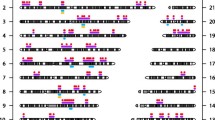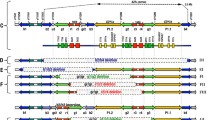Abstract
Male infertility is a multifactorial heterogeneous reproductive disorder in which genetic, epigenetic, and environmental factors play a role in the development of disease. Recent studies have shown that retrotransposon expression alterations may be related to impairment of spermatogenesis. Therefore, in this pilot study, we aimed to investigate whether HERV-K6 and HERV-K11 insertional variations have a role in idiopathic infertility among normozoospermic men. Genomic DNA isolated from the blood samples of 41 infertile normozoospermic and 45 fertile normozoospermic men were analyzed by inter-retrotransposon polymorphism polymerase chain reaction. HERV-K6 variation rates in the infertile and the fertile group were 0–58.3% and 0–53.4%, respectively. The variation rates of HERV-K11 were 0–75.0% in infertile and 0–77.8% in fertile men. The HERV-K6 and HERV-K11 insertion rates of the fertile group were higher than the infertile group (P < 0.0001 and P = 0.007, respectively). The findings of the study suggest that HERV-K6 and HERV-K11 retrotransposon insertion show variation among individuals, and their insertions might be associated with male infertility.


Similar content being viewed by others
Data Availability
The data that support the finding of this study are available from the corresponding author (NH), upon reasonable request.
References
Avila C, Vinay JI, Arese M, Saso L, Rodrigo R. Antioxidant intervention against male infertility: time to design novel strategies. Biomedicines. 2022;10:12.
Gunes S, Esteves SC. Role of genetics and epigenetics in male infertility. Andrologia. 2021;53:e13586.
Boitrelle F, Shah R, Saleh R, Henkel R, Kandil H, Chung E, Vogiatzi P, Zini A, Arafa M, Agarwal, A. The sixth edition of the WHO manual for human semen analysis: a critical review and SWOT analysis. Life (Basel). 2021;11:1368. https://doi.org/10.3390/life11121368.
Ayarpadikannan S, Kim HS. The impact of transposable elements in genome evolution and genetic instability and their implications in various diseases. Genomics Inform. 2014;12:98–104.
Carotti E, Carducci F, Canapa A, Barucca M, Greco S, Gerdol M, et al. Transposable elements and teleost migratory behaviour. Int J Mol Sci. 2021;22:2.
Scognamiglio S, Grandi N, Pessiu E, Tramontano E. Identification, comprehensive characterization, and comparative genomics of the HERV-K(HML8) integrations in the human genome. Virus Res. 2022;323:198976.
Xue B, Sechi LA, Kelvin DJ. Human endogenous retrovirus K (HML-2) in health and disease. Front Microbiol. 2020;11:1690.
Agoni L, Lenz J, Guha C. Variant splicing and influence of ionizing radiation on human endogenous retrovirus K (HERV-K) transcripts in cancer cell lines. PLoS One. 2013;8:e76472.
Seifarth W, Spiess B, Zeilfelder U, Speth C, Hehlmann R, Leib-Mosch C. Assessment of retroviral activity using a universal retrovirus chip. J Virol Methods. 2003;112:79–91.
Bhat A, Ghatage T, Bhan S, Lahane GP, Dhar A, Kumar R, et al. Role of transposable elements in genome stability: implications for health and disease. Int J Mol Sci. 2022;23:14.
Arafat M, Har-Vardi I, Harlev A, Levitas E, Zeadna A, Abofoul-Azab M, et al. Mutation in TDRD9 causes non-obstructive azoospermia in infertile men. J Med Genet. 2017;54:633–9.
Cheng YS, Wee SK, Lin TY, Lin YM. MAEL promoter hypermethylation is associated with de-repression of LINE-1 in human hypospermatogenesis. Hum Reprod. 2017;32:2373–81.
Hempfling AL, Lim SL, Adelson DL, Evans J, O’Connor AE, Qu ZP, et al. Expression patterns of HENMT1 and PIWIL1 in human testis: implications for transposon expression. Reproduction. 2017;154:363–74.
Cakmak Guner B, Karlik E, Marakli S, Gozukirmizi N. Detection of HERV-K6 and HERV-K11 transpositions in the human genome. Biomed Rep. 2018;9:53–9.
Cooper TG, Noonan E, von Eckardstein S, Auger J, Baker HW, Behre HM, et al. World Health Organization reference values for human semen characteristics. Hum Reprod Update. 2010;16:231–45.
Hekim N, Aydin M, Gunes S, Asci R. Follicle-stimulating hormone beta subunit and receptor variations in infertile men in Central Black Sea Region of Turkey. Andrologia. 2022;54:e14383.
Azebi S, Batsche E, Michel F, Kornobis E, Muchardt C. Expression of endogenous retroviruses reflects increased usage of atypical enhancers in T cells. EMBO J. 2019;38:12.
Kim HS. Genomic impact, chromosomal distribution and transcriptional regulation of HERV elements. Mol Cells. 2012;33:539–44.
Lazaros L, Kitsou C, Kostoulas C, Bellou S, Hatzi E, Ladias P, et al. Retrotransposon expression and incorporation of cloned human and mouse retroelements in human spermatozoa. Fertil Steril. 2017;107:821–30.
Zwolinska K, Knysz B, Gasiorowski J, Pazgan-Simon M, Gladysz A, Sobczynski M, et al. Frequency of human endogenous retroviral sequences (HERV) K113 and K115 in the Polish population, and their effect on HIV infection. PLoS One. 2013;8:e77820.
Kim HS, Choi JY, Lee WH, Jang KL, Hyun BH. Nucleotide sequence and phylogenetic analysis of long terminal repeats of human endogenous retrovirus K family (HERV-K) on human chromosomes. Microb Comp Genomics. 2000;5:121–7.
Kim HS, Crow TJ. Presence and phylogenetic analysis of HERV-K LTR on human X and Y chromosomes: evidence for recent proliferation. Genes Genet Syst. 1999;74:267–70.
Choi J, Koh E, Matsui F, Sugimoto K, Suzuki H, Maeda Y, et al. Study of azoospermia factor-a deletion caused by homologous recombination between the human endogenous retroviral elements and population-specific alleles in Japanese infertile males. Fertil Steril. 2008;89:1177–82.
Thangaraj K, Gupta NJ, Pavani K, Reddy AG, Subramainan S, Rani DS, et al. Y chromosome deletions in azoospermic men in India. J Androl. 2003;24:588–97.
Sin HS, Koh E, Taya M, Iijima M, Sugimoto K, Maeda Y, et al. A novel Y chromosome microdeletion with the loss of an endogenous retrovirus related, testis specific transcript in AZFb region. J Urol. 2011;186:1545–52.
Funding
The present was supported by Ondokuz Mayis University Research Foundation (Project no: PYO.TIP.1901.19.007).
Author information
Authors and Affiliations
Contributions
SG and NH contributed to the study conception and design. Patient diagnosis was made by RA. Data collection and analysis were performed by NH. The manuscript was written by NH and edited by SG and RA. All authors commented on previous versions of the manuscript.
Corresponding author
Ethics declarations
Ethics Approval
The protocol and the consent forms of study were approved by the Ondokuz Mayıs University Clinical Research Ethics Committee with the reference number 2018/479. All participants signed a consent form stating that they have informed about the study and confirmed their participation. Participants or animals performed by any of the authors.
Consent to Participate
Informed consent was obtained from all individual participants included in the study.
Conflict of Interest
The authors declare no competing interests.
Additional information
Publisher's Note
Springer Nature remains neutral with regard to jurisdictional claims in published maps and institutional affiliations.
Supplementary Information
Below is the link to the electronic supplementary material.
43032_2023_1346_MOESM1_ESM.xlsx
Supplemetary Table. Jaccard’s similarity index of HERV-K6 and HERV-K11 polymorphisms in patients and controls (XLSX 42 KB)
Rights and permissions
Springer Nature or its licensor (e.g. a society or other partner) holds exclusive rights to this article under a publishing agreement with the author(s) or other rightsholder(s); author self-archiving of the accepted manuscript version of this article is solely governed by the terms of such publishing agreement and applicable law.
About this article
Cite this article
Hekim, N., Gunes, S., Ergun, S. et al. Insertional Variations of Human Endogenous Virus K6 and K11 in Normozoospermic Men. Reprod. Sci. 31, 267–274 (2024). https://doi.org/10.1007/s43032-023-01346-1
Received:
Accepted:
Published:
Issue Date:
DOI: https://doi.org/10.1007/s43032-023-01346-1




